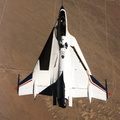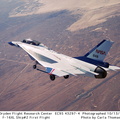
WIKIARCHIVES.SPACE
The Human Spaceflight Archive

The laminar flow control panel in the left wing (dark area, forward center) of NASA's F-16XL is highly visible in this photo taken Oct. 13, 1995, during the first functional check flight of the aircraft following the experimental panel's installation. The laminar flow research project, flown at NASA's Dryden Flight Research Center, Edwards, California, investigated the use of a suction system built into the experimental panel and wing to remove a small part of the boundary layer of air above the aircraft wing to expand the extent of laminar (smooth) flow.
Information
- Taken in
- Author
- NASA
- Description
-
The laminar flow control panel in the left wing (dark area, forward center) of NASA's F-16XL is highly visible in this photo taken Oct. 13, 1995, during the first functional check flight of the aircraft following the experimental panel's installation. The laminar flow research project, flown at NASA's Dryden Flight Research Center, Edwards, California, investigated the use of a suction system built into the experimental panel and wing to remove a small part of the boundary layer of air above the aircraft wing to expand the extent of laminar (smooth) flow.
This can reduce aerodynamic drag and help reduce aircraft operating costs by improving fuel consumption. Data from the NASA research project may lead to the use of a similiar suction system to achieve laminar flow on future supersonic transports and fighter aircraft.
- Created on
- Friday 13 October 1995
- Albums
- US SPACE PROGRAM / AERONAUTICS RESEARCH / F-16 / F-16XL-2
- Source link
- https://www.dfrc.nasa.gov/Gallery/Photo/F-16XL2/index.html
- Visits
- 17
- Rating score
- no rate
- Rate this photo
- License
- Public Domain
- Modified by WikiArchives
- No (original)
- Downloads
- 1
Powered by Piwigo




